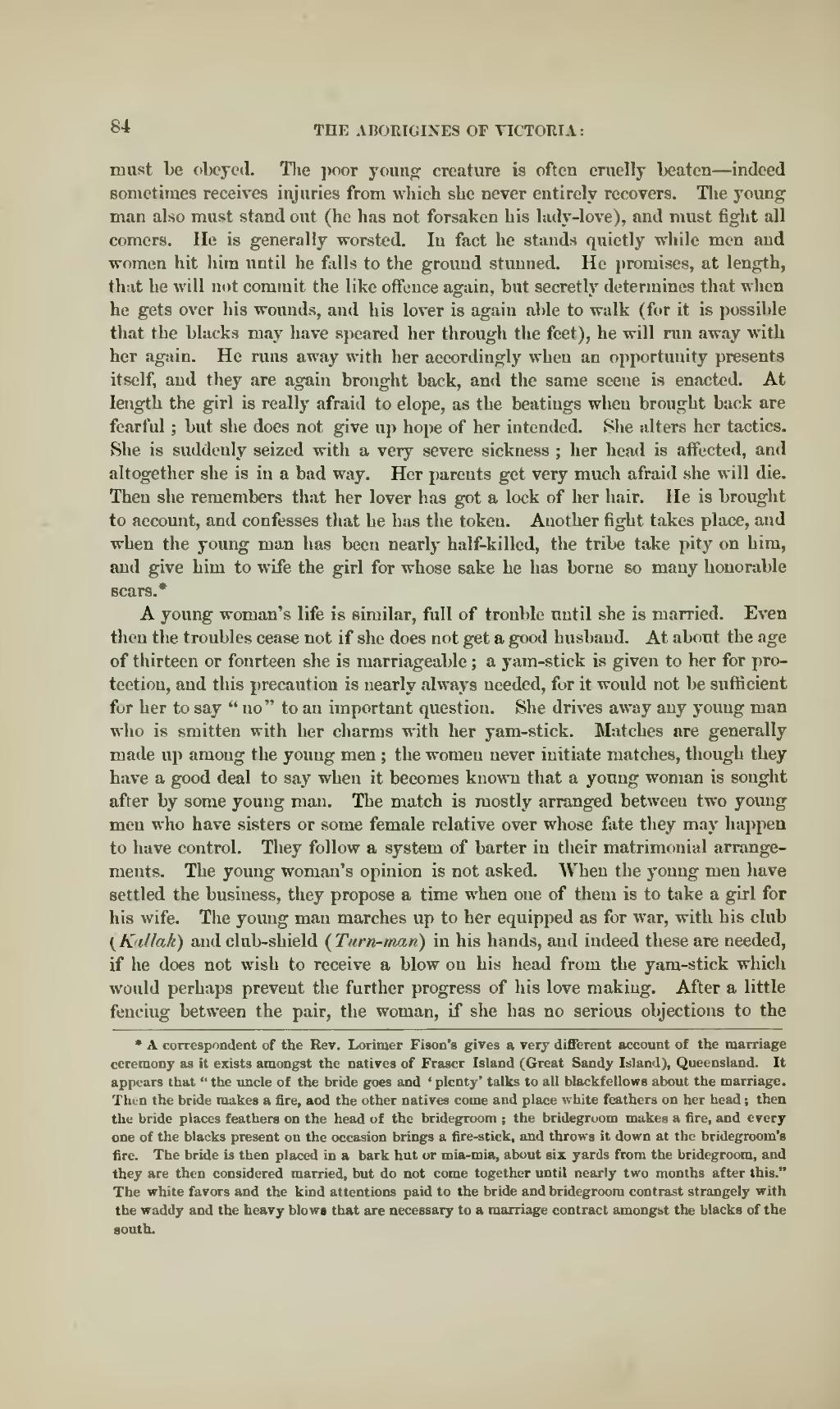must be obeyed. The poor young creature is often cruelly beaten—indeed sometimes receives injuries from which she never entirely recovers. The young man also must stand out (he has not forsaken his lady-love), and must fight all comers. He is generally worsted. In fact he stands quietly while men and women hit him until he falls to the ground stunned. He promises, at length, that he will not commit the like offence again, but secretly determines that when he gets over his wounds, and his lover is again aide to walk (for it is possible that the blacks may have speared her through the feet), he will run away with her again. He runs away with her accordingly when an opportunity presents itself, and they are again brought back, and the same scene is enacted. At length the girl is really afraid to elope, as the beatings when brought back are fearful; but she does not give up hope of her intended. She alters her tactics. She is suddenly seized with a very severe sickness; her head is affected, and altogether she is in a bad way. Her parents get very much afraid she will die. Then she remembers that her lover has got a lock of her hair. He is brought to account, and confesses that he has the token. Another fight takes place, and when the young man has been nearly half-killed, the tribe take pity on him, and give him to wife the girl for whose sake he has borne so many honorable scars.[1]
A young woman's life is similar, full of trouble until she is married. Even then the troubles cease not if she does not get a good husband. At about the age of thirteen or fonrteen she is marriageable; a yam-stick is given to her for protection, and this precaution is nearly always needed, fur it would not be sufficient for her to say "no" to an important question. She drives away any young man who is smitten with her charms with her yam-stick. Matches are generally made up among the young men; the women never initiate matches, though they have a good deal to say when it becomes known that a young woman is sought after by some young man. The match is mostly arranged between two young men who have sisters or some female relative over whose fate they may happen to have control. They follow a system of barter in their matrimonial arrangements. The young woman's opinion is not asked. When the young men have settled the business, they propose a time when one of them is to take a girl for his wife. The young man marches up to her equipped as for war, with his club (Kallak) and club-shield (Turn-man) in his hands, and indeed these are needed, if he does not wish to receive a blow on his head from the yam-stick which would perhaps prevent the further progress of his love making. After a little fencing between the pair, the woman, if she has no serious objections to the
- ↑ A correspondent of the Rev. Lorimer Fison's gives a very different account of the marriage ceremony as it exists amongst the natives of Fraser Island (Great Sandy Island), Queensland. It appears that "the uncle of the bride goes and 'plenty' talks to all blackfellows about the marriage. Then the bride makes a fire, and the other natives come and place white feathers on her head; then the bride places feathers on the head of the bridegroom; the bridegroom makes a fire, and every one of the blacks present on the occasion brings a fire-stick, and throws it down at the bridegroom's fire. The bride is then placed in a bark hut or mia-mia, about six yards from the bridegroom, and they are then considered married, but do not come together until nearly two months after this." The white favors and the kind attentions paid to the bride and bridegroom contrast strangely with the waddy and the heavy blows that are necessary to a marriage contract amongst the blacks of the south.
